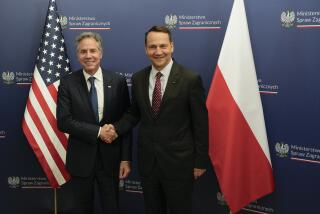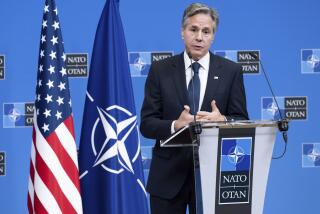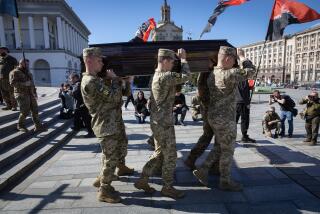U.S. Warms to Its Old Warsaw Pact Enemies : Diplomacy: Cheney’s visits in former Eastern Bloc are dramatic evidence of a blossoming relationship.
- Share via
PRAGUE, Czechoslovakia — Under a cold gray sky, U.S. Defense Secretary Dick Cheney stood shoulder to shoulder with his Czech counterpart here and watched as the grim and greatcoated soldiers of a former adversary goose-stepped past him.
The ritual greeting by a friendly nation last week marked the start of the first visit ever by an American defense secretary to Prague and, with it, the end of an era in which Pentagon officials shunned Eastern European countries and demonized their militaries.
Cheney’s visit came four days after the Bush Administration granted Czechoslovakia, Hungary and Poland the right to buy U.S. arms for the first time since World War II and just hours after the Pentagon chief concluded an unprecedented round of talks with Hungarian defense officials.
But it has come none too soon for East European military leaders, who crave everything from American arms and tactical expertise to the Pentagon’s management concepts and its notion of civilian-military relations.
Cheney’s visits to Hungary and Czechoslovakia are the most dramatic evidence to date of burgeoning relationships between the Pentagon and the military establishments of countries that used to belong to the Warsaw Pact, the Soviet-led bloc of military powers that once menaced Western Europe.
This week, that blossoming partnership is to receive a major new push as foreign ministers of the North Atlantic Treaty Organization, for the first time, meet in Brussels to discuss security ties with their counterparts from the former Warsaw Pact.
Pentagon officials said that efforts to strengthen those ties could become the model for future military-to-military relationships with breakaway Soviet republics. The newly minted defense leaders from several of those fledgling republics, including Ukraine and the Baltics, have indicated to Washington that they are “hungry” for such consultations to begin, a knowledgeable Pentagon official said. But Pentagon leaders must wait for the political and diplomatic status of these entities, and the crucial question of control over nuclear weapons, to be sorted out before military-to-military relations can begin.
In Prague and Budapest, Cheney listened to the Czechs’ and Hungarians’ mounting security concerns. He signed agreements to conduct cooperative mapping projects and establish working groups that will help those militaries restructure and reorganize their armed forces to operate under new democratic governments.
They were “the first of many agreements,” Cheney promised both of his hosts. As a result of a visit by Cheney to Poland last December, a similar set of agreements are expected to be concluded with the Poles in the coming months.
Meanwhile, in military schools and command-and-staff colleges across the United States, about a dozen civilian and military leaders from Poland, Czechoslovakia and Hungary already are studying the ways of the American military--to learn not to fight it but to emulate it. Next year, the Pentagon expects to nearly double the number of East European military officers it brings to the United States to learn from American military commanders and managers.
Cheney also said last week that the United States would begin work on cooperative defense research and an exchange of scientists and engineers with the Pentagon’s newfound friends in Eastern Europe. Within the next decade, as they build the financial means and the organizations to support them, Poland, Hungary and Czechoslovakia will almost surely become major purchasers of U.S. arms and equipment, U.S. defense officials said, moves that would mark a decisive break from their postwar roles as Soviet arms clients.
But while ailing U.S. defense firms and the East Europeans themselves are eager to begin the arms trade, Pentagon officials and independent experts caution that there is much to be accomplished before weapons can begin flowing from America to Eastern Europe. These countries are staggering under the weight of their financial problems, and their military establishments are in disarray as they adjust to unaccustomed political and financial restraints, officials on both sides acknowledge.
“These militaries have got plenty of arms for a while, and you don’t want to fuel new regional arms races at a delicate time like this,” said Stanford University’s Condoleeza Rice, formerly a senior Bush Administration official responsible for Soviet and East European affairs. “Any arms supply relationship needs to take place in a whole new context of restructured and reorganized East European militaries. It would be a mistake to try to buy immediate political influence by selling them arms.”
Pentagon leaders appear to share that sentiment. Cheney’s visit to Poland last year brought urgent requests for American F-16 fighter jets, but this year’s visit to Eastern Europe brought no detailed shopping lists from Hungarian or Czechoslovak leaders. One knowledgeable official said their interest in receiving U.S. arms “is right below the surface.” But this year, the East Europeans are too wise to ask.
For the Pentagon, this remarkable new relationship with Eastern Europe has been an opportunity to win fresh friends and future customers. But it has been a worrisome time for the once-monolithic East Bloc. The Soviet Union, the “big brother” of the now-dissolved Warsaw Pact for almost 40 years, has fallen to pieces, leaving these countries scrambling to find spare parts for their Soviet-made equipment.
With the formal dissolution of the Warsaw Pact this summer, members also lost their massive postwar investment in an integrated Warsaw Pact air defense network, which guarded at least the western borders of all these countries from aerial attack.
The result is that the three former adversaries want American equipment--especially air defense equipment--”so bad they can taste it,” according to one knowledgeable defense official.
Internally, East Europe’s militaries are facing massive budget cuts and complete reorganizations as newly elected civilian leaders take up the reins and divert budget money to pressing domestic problems. In Hungary, Defense Minister Lajos Fur readily admits to visitors that, as an agricultural engineer long imprisoned for his opposition to the former government, he knows little about making defense policy. And Czechoslovak officers told U.S. officials that their defense budget in the coming years will tumble to $1 billion a year--a small fraction of earlier years.
Meanwhile, East European militaries see increasing trouble internally as well as on their borders. Hungary watches with horror as civil war grips Yugoslavia to its south and worries that, with ill-equipped ground forces and no effective air defense, it can do nothing to keep the fighting, or its refugees, from spilling over into Hungary. Already, Yugoslav planes have made 30 reported incursions into Hungarian territory.
Poland and Czechoslovakia, similarly vulnerable, fret that newly independent Ukraine, with one of the largest land armies on the Continent and an arsenal of nuclear missiles, might choose adventure over neighborly coexistence. And Czechoslovakia, officially called the Czech and Slovak Federal Republic, already is riven by ethnic tensions between its two major components.
Last week, Hungarian officials told Cheney bluntly that they consider themselves a “front-line” country in the struggle against instability, and Czechoslovak officials offered a similar assessment of their country’s security status.
Given their fears and their vulnerabilities, the three former Warsaw Pact countries have urged NATO not only to stay together but to bring them under its umbrella and offer them formal commitments for their security.
Up to now, however, NATO members have privately cautioned the three East European countries that they will not be granted formal NATO status, and so no formal request has been made.
Healy was recently on assignment in Eastern Europe.
More to Read
Sign up for Essential California
The most important California stories and recommendations in your inbox every morning.
You may occasionally receive promotional content from the Los Angeles Times.











